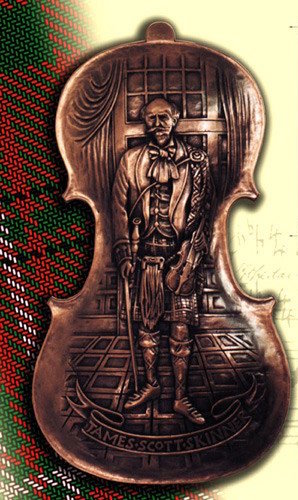Pyrography, or wood burning, a craft dating back to ancient African and Egyptian cultures, is done with a wood-burning pen. The term means "writing with fire", from the Greek pur (fire) and graphos (writing). Heat is applied to the wood, and different effects created by varying the type of tip or the temperature.
When we think of wood burning crafts, images of rustic craft work spring to mind: Pieces of tree trunk embellished with a house name burned into the timber, or a natural wood desk calendar, perhaps.
Romanian, Dino Muradian is a self-taught pyrographer. He works as a freelance artist, customising guitars, violins and other instruments for a living. He has been practising wood burning for 50 years, during which he has developed his own tools and techniques, creating pieces that are entirely different from the usual pokerwork artefacts. His violins are works of art:
But these violins would not be playable or practical for everyday use without varnish.
The varnish of the violin is very important to the sound or tone of the instrument. In physical terms, the main effect of the varnish of the violin is to change the elastic properties of the wood. Wood is naturally strong in the direction of the grain and weak in directions transverse to the grain. As the varnish penetrates into the wood, its polymer properties strengthen the crosswise fibres. The net result is a change in the stiffness of the wood. This hardening changes the vibrational properties of the violin’s timber.
In an unvarnished violin, the sound is faster along the grain and slower perpendicular to it. When varnish is applied, these differences are reduced, leading to a more uniform sound radiation. Varnish also protects the violin against the long-term effects of wear and humidity.
This video shows an unvarnished, or ‘white’ violin being played. The tone is undeveloped.
Unfinished white violins are commonly available through online platforms such as eBay, but the tools and skill required to convert these to playable instruments would outweigh any benefit of the cheap purchase price or the temptation to build a custom-made, working instrument. The violin will require finishing and setting up. The fingerboard, which on a cheap violin is often attached with virtually heatproof glue, will need to be removed so that the instrument can be varnished.
However, these instruments are perfect if for anyone interested in creating an artwork from the violin rather than a functioning instrument.
The violin in its usual state is a thing of beauty as well as function, but sometimes violins and other string instruments are heavily decorated and still work brilliantly. A cello may have a coat of arms on the back - Andrea Amati’s ‘King’ cello, dating from somewhere after 1532 bears the royal arms of Charles IX of France. This indicates that this instrument must have represented the best work that Charles, or his commissioners, could find. The decoration on this instrument is painted, not carved or inlaid.
Older instruments, ancestors of the violin, such as the Venetian lira da braccio by Francesco Linarol have elaborate inlays, while Stradivarius’s decoration was subtle in the extreme – delicate, florid inlays in the ribs of the violin.
Most decorative work on violins has been imitative of the painted armorials of Amati or the embellished purfling and mastic inlay used by Stradivari. But despite the use of decoration by these greatest of makers, decorated instruments generally have a poor reputation among players. Most violinists prefer not to stand out from the crowd or risk the fragility, buzzing and rattling that can come with inlays.
Ornamentation and decoration add nothing to the sound quality, and if carried to excess are likely to detract from the tone. The more inlay added to a violin, the less of the body can vibrate freely and the more things there are to go wrong. Carvings such as that on the back of Scottish fiddler James Scott Skinner’s violin create different thicknesses in the wood. The thickest parts will not vibrate as freely as the back of a normal violin and this will affect the sound.
The Norwegian Hardanger Fiddle is the one sort of ‘played’ violin that is commonly highly carved. The wood burned designs and carved heads traditional to Hardanger fiddles create a truly unique look to these instruments.
If you are interested in creating a wood-burning project on a white violin, it is important to note that woods can emit toxins when burned and may cause serious respiratory problems when inhaled. Be sure to take precautions, such as wearing a good dust mask, and gloves when sanding to prevent a rash. Many violins are made from spruce and maple. Spruce can create respiratory sensitivity and maple wood can create skin rashes and respiratory problems. Work outside or position a fan to ventilate the space.

[Image from The Strathspey King, Temple Records]
Please visit our sponsors:
London String School - Tuition for Adult Learners in London
MusicLand - Creative Music Products for Teachers and Learners
Please visit our sponsors:
FiddlerShop.com - Quality instruments at an affordable price
London String School - Tuition for Adult Learners in London
MusicLand - Creative Music Products for Teachers and Learners
